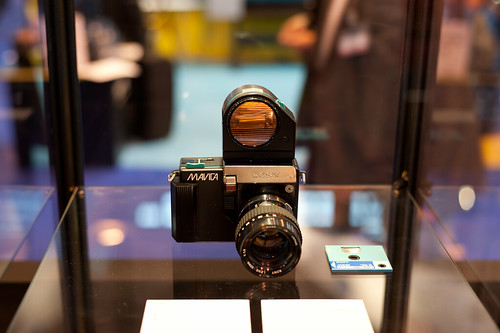Difference between revisions of "Sony Mavica (1981)"
Hanskerensky (talk | contribs) (Repaired Link URL, Added Category:Sony) |
(→Links: period article in Pop Photo via Google Books) |
||
| (One intermediate revision by the same user not shown) | |||
| Line 13: | Line 13: | ||
Thirty years later, electronic cameras had become universal, but the Mavica was not a "digital" camera. While its imaging sensor had a resolution of roughly 0.28 megapixels<REF>[http://www.sonyinsider.com/2009/03/11/akio-morita-and-1981s-mavica-electronic-camera/ "Akio Morita And 1981′s Sony Mavica Electronic Camera"] in Sony's company blog [http://www.sonyinsider.com/ SonyInsider.com]</REF>, the images were saved in the form of analog scan lines, in the same manner as a television image. | Thirty years later, electronic cameras had become universal, but the Mavica was not a "digital" camera. While its imaging sensor had a resolution of roughly 0.28 megapixels<REF>[http://www.sonyinsider.com/2009/03/11/akio-morita-and-1981s-mavica-electronic-camera/ "Akio Morita And 1981′s Sony Mavica Electronic Camera"] in Sony's company blog [http://www.sonyinsider.com/ SonyInsider.com]</REF>, the images were saved in the form of analog scan lines, in the same manner as a television image. | ||
| + | |||
| + | Sony would eventually release the [[Sony Mavica MVC-A7AF | Mavica MVC-A7AF]] in 1987 as its first commercial realization of the Mavica still-video concept. | ||
==Notes== | ==Notes== | ||
| Line 20: | Line 22: | ||
*[http://www.sonyinsider.com/2009/03/11/akio-morita-and-1981s-mavica-electronic-camera/ "Akio Morita And 1981′s Sony Mavica Electronic Camera"] in Sony's company blog [http://www.sonyinsider.com/ SonyInsider.com] | *[http://www.sonyinsider.com/2009/03/11/akio-morita-and-1981s-mavica-electronic-camera/ "Akio Morita And 1981′s Sony Mavica Electronic Camera"] in Sony's company blog [http://www.sonyinsider.com/ SonyInsider.com] | ||
*[https://www.digitalkameramuseum.de/en/esvc/item/mavica-1981 "Sony Mavica"] in the digital camera museum [https://www.digicammuseum.com/en/ digicammuseum.com] | *[https://www.digitalkameramuseum.de/en/esvc/item/mavica-1981 "Sony Mavica"] in the digital camera museum [https://www.digicammuseum.com/en/ digicammuseum.com] | ||
| + | *[https://books.google.com/books?id=xFlUkKWm46wC&pg=PA130&dq=Mavica&hl=en&sa=X&ved=2ahUKEwiYsr-p2qT9AhWImYkEHQslBLcQ6AF6BAgCEAI#v=onepage&q=Mavica&f=false ''Popular Photography'' analyzes the Mavica] in the November, 1981, issue (Vol. 88, No. 11; pages 130-130, 198, 204) via [https://books.google.com/ Google Books] | ||
[[Category:Still video]] | [[Category:Still video]] | ||
[[Category:1981]] | [[Category:1981]] | ||
[[Category:Sony]] | [[Category:Sony]] | ||
Latest revision as of 18:24, 20 February 2023

|
| 1981 Mavica and Mavipak disk image by tonic_witch (Image rights) |
In 1981, Sony startled the photographic world by creating a filmless, electronic camera for stills called the Mavica (from magnetic video camera). While exhibited only in prototype form, this camera pioneered an entire "still video" market segment, later to include the Canon RC-701 among others. It had an SLR design and was shown with 3 interchangeable lenses: 25mm f/2, a 50mm f/1.4 and a 16-64mm f/1.4 zoom[1].
The Mavica used a new "Mavipak" miniature floppy disk in a plastic case measuring about 2" square, able to store up to 50 images. This format was subsequently adopted as the video floppy standard and used in cameras from other companies. (Sony developed the 3.5" computer floppy disk in the same year.)
Thirty years later, electronic cameras had become universal, but the Mavica was not a "digital" camera. While its imaging sensor had a resolution of roughly 0.28 megapixels[2], the images were saved in the form of analog scan lines, in the same manner as a television image.
Sony would eventually release the Mavica MVC-A7AF in 1987 as its first commercial realization of the Mavica still-video concept.
Notes
- ↑ "Flashback Friday: Sony MAVICA Digital Camera (1981)" (archived) from The Sony Blog
- ↑ "Akio Morita And 1981′s Sony Mavica Electronic Camera" in Sony's company blog SonyInsider.com
Links
- "Akio Morita And 1981′s Sony Mavica Electronic Camera" in Sony's company blog SonyInsider.com
- "Sony Mavica" in the digital camera museum digicammuseum.com
- Popular Photography analyzes the Mavica in the November, 1981, issue (Vol. 88, No. 11; pages 130-130, 198, 204) via Google Books